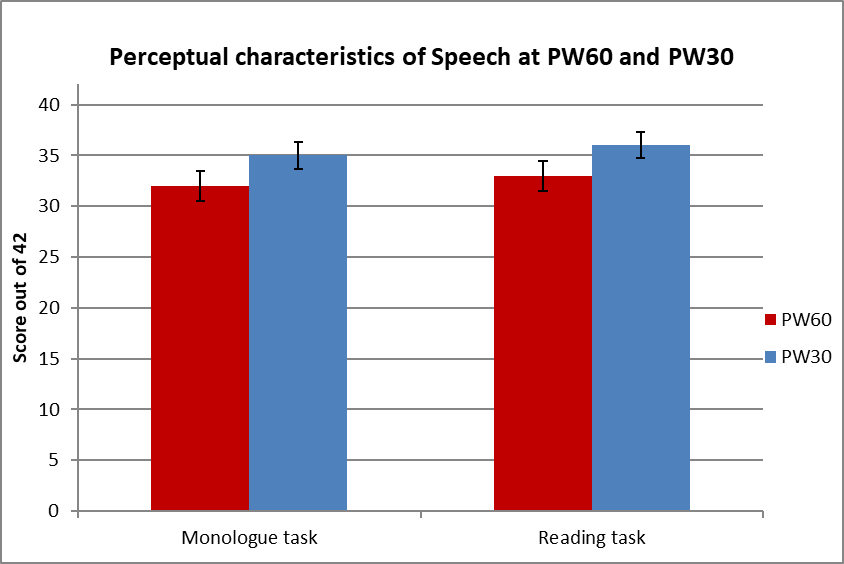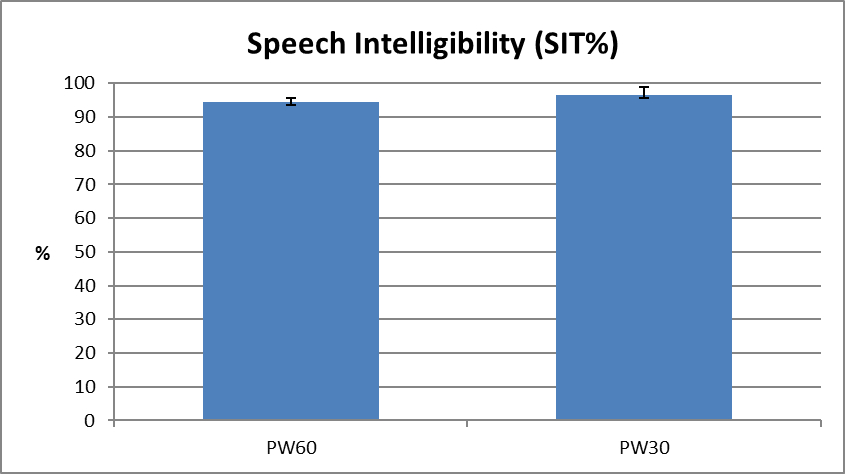Session Information
Date: Saturday, October 6, 2018
Session Title: Parkinson’s Disease: Clinical Trials, Pharmacology And Treatment
Session Time: 1:45pm-3:15pm
Location: Hall 3FG
Objective: To compare perceptual characteristics and intelligibility of speech in Parkinson’s Disease (PD) patients with Subthalamic Nucleus Deep Brain Stimulation (STN-DBS) in the acute setting at Pulse Width of 30µs (PW30) and the standard pulse parameter of 60µs (PW60).
Background: STN-DBS is an established treatment for selected PD patients, but therapy is often limited by side effects such as speech impairment. Recent studies have shown that the therapeutic window of STN-DBS using a pulse width (PW) shorter than the conventional 60µs setting significantly expands the therapeutic window, but there is limited data on the effect on speech (1).
Methods: 15 consecutive PD patients [mean age 54 ± 8; disease duration 13 ± 4 years; UPDRS-III 43 ± 9 ON, 15 ± 6 OFF] who had STN-DBS implanted and monopolar review of programming performed 2-10 days post-operatively at PW60 and PW30 were included. Assessment of speech was performed at the efficacy threshold for rigidity control using the most efficacious contact per STN on each PW condition. A speech therapist rated perceptual characteristics of speech using a 60-second monologue (MON) and a reading task (RDG), and speech intelligibility with the Assessment of Intelligibility for Dysarthric Speech scale (SIT%)(2). A paired sample t-test was used for the comparison.
Results: The perceptual speech score for the reading task (RDG) was higher at PW30 (36 ± 5/ 42) compared to PW60 (33 ± 5/ 42); p<0.01, as was the monologue score (MON; 35 ± 5/42 for PW30 vs. 32 ± 5 at PW60; p=0.01). The SIT% score at PW30 (96.5 ± 4.1%) was not significantly different to that at PW60 (94.7 ± 8.7 %); p>0.05. [Figure 1] [Figure 2].
Conclusions: STN-DBS in PD patients using a PW of 30µs may improve perceptual characteristics of speech compared to conventional PW settings. Speech intelligibility as measured by the SIT% score was not significantly improved using PW30 in this cohort. However, this should be further explored in patients with symptomatic speech impairment and longer term follow up on the two conditions.
References: 1. Steigerwald F, Timmermann L, Kühn A, Schnitzler A, Reich MM, Kirsch AD, et al. Pulse duration settings in subthalamic stimulation for Parkinson’s disease. Mov Disord. 2017;0(0):1–5. 2. Yorkston, K, Beukelman D. (1984) Assessment of Intelligibility of Dysarthric Speech. Austin: Pro-ed, CC Publications.
To cite this abstract in AMA style:
V. Dayal, T. Grover, E. Tripoliti, P. Limousin, T. Foltynie. The Effect of Short Pulse Width Settings on Speech in Subthalamic Nucleus Deep Brain Stimulation for Parkinson’s disease [abstract]. Mov Disord. 2018; 33 (suppl 2). https://www.mdsabstracts.org/abstract/the-effect-of-short-pulse-width-settings-on-speech-in-subthalamic-nucleus-deep-brain-stimulation-for-parkinsons-disease/. Accessed December 7, 2025.« Back to 2018 International Congress
MDS Abstracts - https://www.mdsabstracts.org/abstract/the-effect-of-short-pulse-width-settings-on-speech-in-subthalamic-nucleus-deep-brain-stimulation-for-parkinsons-disease/


